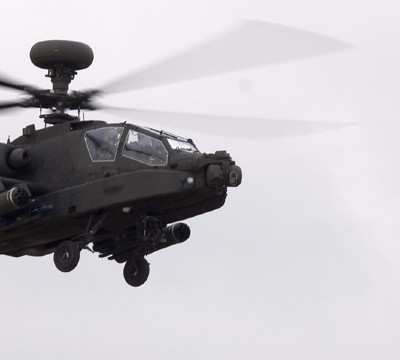But They Had A Very Good Reason
It sounds likes something from Monty Python, but it's true: the
first live missile warshot fired by Britain's Apache helicopters in
Afghanistan was fired at a French vehicle. And the French actually
thanked them.

The off-road vehicle was disabled when French special operations
forces and Afghan soldiers were ambushed by Taliban insurgents in
southwestern Afghanistan's Helmand province last week. The
lightly-armed French and Afghan column ended up in an eight-hour
firefight with a much larger quantity of Taliban fighters. But they
were saved by the cavalry -- a cavalry bearing the name of a
legendary tribe of Indian warriors.
British Apache attack helicopters, working in pairs and firing
their 30-mm cannons, were able to disrupt the Taliban attack,
acting as "flying artillery." British infantry were also landed,
but with night falling the commander on the scene decided to
withdraw. One of the French vehicles could not be recovered, and
had to be abandoned in place. The Hellfire anti-tank missile was
fired to destroy the vehicle so that the enemy could not salvage
it.

Each Hellfire missile costs the British people 65,000 UK pounds.
Apart from the expenditure, the British forces suffered no
losses.
The original column was not so fortunate. The French commandos
lost two men and the Afghan government forces 16. Over 40 friendly
forces were wounded. Taliban killed were estimated at over 100.
The French unit was reportedly the 1er Regiment Parachutiste
d'Infanterie de Marine (RPIMA), home-based in Bayonne, generally
considered the nation's most elite force.
 While the term
"Taliban" is used as a catch-all for Afghan insurgents, the
government of Afghanistan has charged that many of the insurgents
are being recruited overseas and trained and equipped in Pakistan,
a charge that Pakistan's authorities deny categorically. The
Coalition forces have not been willing to discuss the origin of the
hundreds of Taliban; Brigadier Ed Butler, the senior UK commander
in Helmand, would only admit that, "[W]e have porous borders around
us and that is a concern."
While the term
"Taliban" is used as a catch-all for Afghan insurgents, the
government of Afghanistan has charged that many of the insurgents
are being recruited overseas and trained and equipped in Pakistan,
a charge that Pakistan's authorities deny categorically. The
Coalition forces have not been willing to discuss the origin of the
hundreds of Taliban; Brigadier Ed Butler, the senior UK commander
in Helmand, would only admit that, "[W]e have porous borders around
us and that is a concern."
Unless their objective is press coverage, the nationwide
offensive has generally been a failure for the Taliban; their
attacks have been beaten back, and they've suffered heavy
casualties, while inflicting relatively few. The open question is
whether the NATO armies, which primarily came to Afghanistan to
operate Provincial Reconstruction Teams focused on nation-building,
will remain if they're plunged into further fighting.
So far, the fighting is mainly going NATO's way -- and a
significant factor is the presence of the Apache helicopters.
British Apaches are constructed under license in the UK by
Agusta-Westland as the AH Mk1 and are equivalent to the US AH-64D
Apache Longbow, but have Rolls-Royce RTM322 engines in place of the
GE T700s in their American cousins. (The Apache photograph with
this article is a photograph of one of the now-deployed Apaches on
a predeployment exercise in the UK).
In addition to the US, which operates some 500 Apache Longbows,
and the UK, seven other nations have ordered the attack helicopter:
Egypt, Greece, Holland, Israel, Japan, Kuwait and Singapore.
 Airborne-Flight Training 05.09.24: ERAU at AIAA, LIFT Diamond Buy, Epic A&P
Airborne-Flight Training 05.09.24: ERAU at AIAA, LIFT Diamond Buy, Epic A&P ANN's Daily Aero-Term (05.07.24): Hazardous Weather Information
ANN's Daily Aero-Term (05.07.24): Hazardous Weather Information Aero-News: Quote of the Day (05.07.24)
Aero-News: Quote of the Day (05.07.24) NTSB Final Report: Cessna 150
NTSB Final Report: Cessna 150 Aero-News: Quote of the Day (05.08.24)
Aero-News: Quote of the Day (05.08.24)





